How to Conduct a CRM Audit (That Actually Leads to Change)
Raise your hand if you've ever opened a CRM and immediately thought, "How did we get here?" I’ve been there — more times than I can count.
Most audits start as spreadsheets and end as abandoned docs. Someone says, “We need to clean this up,” so the team pulls a list of fields, automations, and reports… and then? Nothing changes.
Over the past seven years auditing CRMs across HubSpot, Salesforce, and HighLevel, I developed the Five-Pillar CRM Audit Framework I use on every engagement. It keeps audits focused, organized, and actionable.
And if the structure is right - you've wasted hours of "digging" for nothing.
In this guide, you’ll learn:
How to define your audit purpose (so you don’t waste time documenting noise)
The five pillars every CRM audit should include
How to turn report into a roadmap
How to build an ongoing audit rhythm that scales
Step 1: Start With the Why
Before you touch a field or open a workflow, clarify why you’re auditing.
Are you scaling? Fixing broken automations? Preparing for a data migration?
Your purpose determines your focus.
Write it down in one line. Example:
“We’re auditing HubSpot to improve visibility between Marketing and Sales and reduce duplicate data.”
That one sentence will keep you from spiraling into a 500-field spreadsheet no one reads.
Step 2: Organize Your Audit Into Five Core Pillars
Every CRM looks different, but I’ve found audits stay clear and useful when you evaluate them through these five pillars:
The Five Pillars (my framework):
Data Hygiene
Process Alignment
Automation Health
Reporting & Visibility
Enablement & Adoption
Let's discuss each one and I'll give samples of what you can review in each area.
1 - Data Hygiene
This is where everything begins — clean data equals clean decisions.
Goal: Ensure accuracy, ownership, and structure.
What to Review:
Duplicates, incomplete, or outdated records
Required fields, naming conventions, and ownership
Dropdown values and picklists for consistency
Key metrics (Lead Source, Close Date, Deal Stage)
Guidance:
Export all properties into a spreadsheet and mark what’s redundant, unused, or unclear.
If you don’t know why a field exists, it’s probably time to archive or consolidate it.
2 - Process Alignment
Your CRM should mirror how your business actually runs not how someone thought it did six months ago.
Goal: Confirm that pipelines, lifecycles, and handoffs match real operations.
What to Review:
Lifecycle stages and entry/exit criteria
Deal or ticket stage definitions
Cross-team handoffs (Sales → CS → RevOps)
Pipeline alignment with customer journey
Guidance:
Interview at least different stakeholders and managers from each team and ask:
“What happens before and after your part of the process?”
Then compare their answers to what the CRM shows. You’ll immediately see where the system doesn’t match reality.
3 - Automation Health
Automations are powerful — until they start conflicting, looping, or running in the wrong order.
Goal: Identify where workflows help or hinder performance.
What to Review:
Triggers, conditions, and re-enrollment settings
Duplicated or conflicting automations
Workflow naming conventions and documentation
Ownership and last review date
Guidance:
Create an Automation Index — one simple table with:
Workflow Name
Purpose
Owner
Status (Active/Paused)
You’ll spot gaps and redundancies in minutes.
4- Reporting & Visibility
Reports should tell a story, not just display data.
Goal: Align dashboards to business questions and decisions.
What to Review:
Are reports tied to KPIs that matter?
Are dashboards filtered correctly and consistently?
Are duplicate metrics or conflicting sources confusing teams?
Guidance:
Start from leadership goals:
“What decisions need better data?”
Then design reports that support those — not vanity metrics.
5- Enablement & Adoption
Even the cleanest CRM fails if no one knows how (or why) to use it.
Goal: Ensure your team understands, trusts, and maintains the system.
What to Review:
Training materials and onboarding for new hires
Documentation and change logs
Feedback loops for user suggestions
Usage patterns (login frequency, record updates, field completion)
Guidance:
Ask users:
“What’s confusing or unnecessary inside the CRM right now?”
You’ll learn more in that one question than in hours of data review.
Step 3: Turn Findings Into a Roadmap (Not a Report)
A list of problems isn’t a plan.
Once your audit’s complete, categorize your findings into three layers:
Quick Wins (1–2 weeks)
Duplicate cleanups
Field consolidation
Naming convention updates
System Enhancements (2–4 weeks)
Pipeline redesigns
Automation rebuilds
Dashboard restructuring
Strategic Projects (1–3 months)
Data governance frameworks
Cross-team integrations
System migrations
Each item should end with:
Who owns it and when it will be done.
That single line turns documentation into direction.
Step 4: Share Your Findings Like a Playbook
Your audit is only valuable if people understand it.
Build a short, visual summary that includes:
Audit purpose and scope
Top three findings per pillar
Before/after visuals or screenshots
Recommended next steps
Keep it short and skimmable. A 20-slide deck no one opens is worse than no audit at all.
Step 5: Make It a Rhythm, Not a Rescue Mission
A CRM audit isn’t something you “do when it’s bad.”
It’s a maintenance habit.
Here’s a simple cadence:
Monthly: Field cleanup + automation review
Quarterly: Stage validation + dashboard check
Annually: Full pillar-by-pillar audit
The goal isn’t perfection — it’s consistency.
When audits become routine, your CRM becomes scalable.
Common Audit Mistakes to Avoid
Auditing in isolation — always involve stakeholders early.
Trying to fix everything at once — focus on impact.
Skipping documentation — what’s not recorded won’t stay fixed.
Ignoring adoption — tools don’t create trust; training does.
Ready to Run a Real Audit?
If your CRM feels messy, inconsistent, or underused, this is your sign.
My CRM audits include:
Full Audit Report: Deep dive into architecture, workflows, and automation health
Prioritized 90-Day Action Plan: Quick wins + long-term improvements
Implementation Strategy Call: A guided walkthrough to turn insights into execution
When you’re ready to clean up your CRM and keep it clean — let’s make it happen.
Thank you so much for reading!
Keep up the momentum with one or more of these next steps:
📣 Sharing helps spread the word, and you’ll look like a total genius when someone receives this blog recommendation from you. + Posts are formatted to be easy to read and share.
📲 Hang out with me on LinkedIn. Don’t be afraid to say hello or message me.
📬 Want to meet online? Schedule a call to connect with me. I'm happy to discuss system, RevOps and grow a new connection.
📊 Need a second set of expert eyes? Book a CRM Audit and Get a 90-day roadmap that helps your systems run cleaner, faster, and smarter. Schedule a CRM Audit Discovery Call. to get started.




